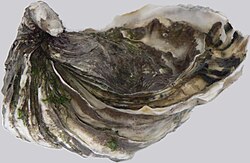Biology:Ostreoidea
| Ostreoidea | |
|---|---|

| |
| Pacific oyster, Magallana gigas | |
| Scientific classification | |
| Domain: | Eukaryota |
| Kingdom: | Animalia |
| Phylum: | Mollusca |
| Class: | Bivalvia |
| Subclass: | Pteriomorphia |
| Order: | Ostreida |
| Superfamily: | Ostreoidea Rafinesque, 1815 |
| Families | |
Ostreoidea is a taxonomic superfamily of bivalve marine mollusc, sometimes simply identified as oysters,[1] containing two families. The ostreoids are characterized in part by the presence of a well developed axial rod.[2] Anal flaps are known to exist within the family Ostreidae but not within the more-primitive Gryphaeidae.[3] The scar from the adductor muscle is simple, with a single, central scar.[4] In the majority, the right valve is less convex than the left.[5]
Anatomy
Harold Harry (1985) gives a detailed description of the morphological and anatomical features that are common in the superfamily. [6] In this section, oyster is used to mean "members of Ostreoidea".
Oysters of this group generally attach to a substrate by cementing their left valve to it. The two valves are unequal: the attached left valve is larger and more cupped than the right 'lid' (to a greater or lesser extent, depending on the species).
The lips of the mantle lobes are joined at the edge opposite the hinge (ventral or posteroventral edge, the hinge is conventionally designated as the dorsal direction). This forms two chambers, one on either side of the visceral mass. The ingress chamber is anatomically anterior and the egress chamber is posterior.[6]:123–124 Within Ostreoidea, the degree of attachment of the left and right mantle lobes to the visceral mass varies between subgroups. The may be one (right) or two passages (left and right), or none, around the body between the adductor and hinge (termed either supramyal or promial passages).[6]:125
Oysters are monomyarian, having one adductor muscle. This is the posterior of the ancestral pair; the anterior muscle is not present in post-larval stages. The adductor is divided into visible halves of translucent "quick" muscle tissue and opaque "catch" tissue. Oysters also lack a foot and the associated body muscles: the foot disappears in early larval stages. This is in contrast to other bivalves with reduced or missing feet where the process occurs later in development.[6]:123
References
- ↑ G. M. Barker (2004). Natural Enemies of Terrestrial Molluscs. CABI. p. 326. ISBN 978-0-85199-061-3. https://books.google.com/books?id=bjAh_Gszsy8C&pg=PA326.
- ↑ Elizabeth Harper; John David Taylor; J. Alistair Crame (2000). The Evolutionary Biology of the Bivalvia. Geological Society of London. p. 175. ISBN 978-1-86239-076-8. https://archive.org/details/evolutionarybiol00harp.
- ↑ Norman Dennis Newell (1998). Bivalves: an eon of evolution : paleobiological studies honoring Norman D. Newell. University of Calgary. p. 28. ISBN 978-1-55238-005-5. https://books.google.com/books?id=Mr4TAQAAIAAJ.
- ↑ Eugene V. Coan; Paul Valentich Scott; F. R. Bernard (2000). Bivalve seashells of western North America: marine bivalve mollusks from Arctic Alaska to Baja California. Santa Barbara Museum of Natural History. p. 52. ISBN 978-0-936494-30-2. https://books.google.com/books?id=mhcWAQAAIAAJ.
- ↑ Ashraf M.T. Elewa (9 June 2010). Morphometrics for Nonmorphometricians. Springer Science & Business Media. p. 163. ISBN 978-3-540-95852-9. https://books.google.com/books?id=JLY-xNUUtvIC&pg=PA163.
- ↑ 6.0 6.1 6.2 6.3 Harry, Harold W. (1985). "Synopsis of the supraspecific classification of living oysters (Bivalvia: Gryphaeidae and Ostreidae)". The Veliger 28 (2): 121–158. https://www.biodiversitylibrary.org/part/94123#/summary. Retrieved 28 March 2020.
Wikidata ☰ Q3357422 entry
 |

